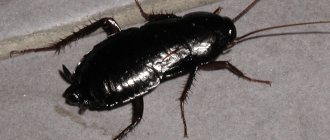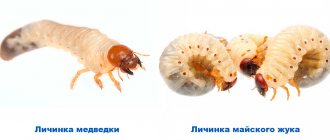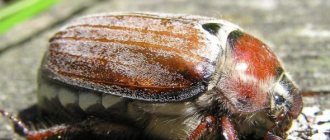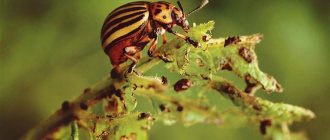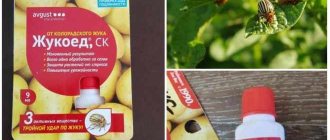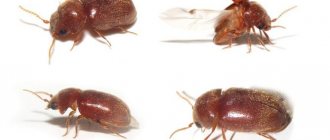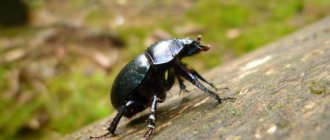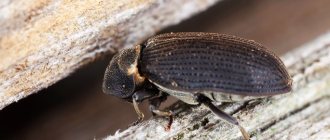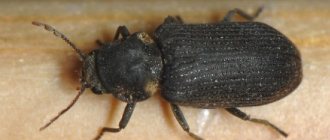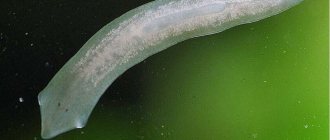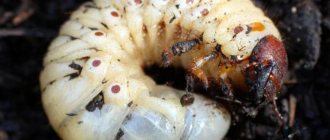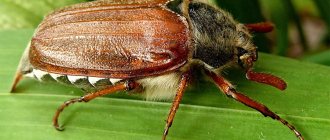External signs of a water strider
Water striders are insects whose name very accurately matches their lifestyle. There are about 700 species of water striders and they all live in water, gliding along the surface of the water with extraordinary ease. With their elongated shape they resemble small boats.
Water striders (lat. Gerridae).
The protective coloration of water striders is brown, dark brown, sometimes almost black. This device allows the water strider to remain invisible to birds against the background of the dark color of the surface of standing reservoirs.
Typically, water striders that live in large bodies of water do not have wings; they simply do not need them.
And the inhabitants of small puddles desperately need wings to fly from place to place as the reservoirs dry up. These water striders have fairly well-developed membranous wings hidden under their elytra, but insects rarely fly.
Undesirable neighborhood
Having settled in a decorative pond, a predatory beetle attacks decorative fish and other inhabitants. Owners of ponds are faced with a difficult problem: how to get rid of the swimming beetle in the pond? The least labor-intensive way is to have crucian carp, which actively destroy the larvae of the swimming beetle. Another option is to temporarily install a pump or fountain that creates movement of the water mass. The insect prefers stagnant bodies of water, so it will leave its shelter and go in search of a better habitat.
If the above methods do not work, then all that remains is to drain the water, clean and disinfect the bottom. This will destroy the adults and larvae of the beetle. After treatment, water is poured in and new inhabitants are released.
Danger to humans
You can encounter a predatory beetle while swimming in a lake or in your own pool. The insect shows aggression towards humans extremely rarely. The bite is painful, but does not pose a threat to health. The swimming beetle bites in the water if it feels threatened. The pain from the skin puncture remains for several minutes. After some time, the wound swells and a lump may form. The beetles are not poisonous, so there is no allergic reaction.
The victim must be given first aid:
- wash the wound;
- treat with an antiseptic (iodine, hydrogen peroxide);
- apply a bandage;
- apply ice to relieve swelling.
Attention. Often, those who pick it up without the necessary skill get bites from the swimming beetle.
Movement of water striders on water
Water striders are real virtuosos of gliding along the surface of the water. They are able to use their long legs to run through the water, like speed skaters on smooth ice.
Having encountered an obstacle - a strip of duckweed or other aquatic plants, the “skaters” make deft leaps and overcome the obstacle with strong leaps. The main participation in such maneuvers belongs to the two rear pairs of legs. The water strider's legs are covered with a fatty substance and are not wetted by water, so the insect easily glides along the surface of the water. In addition, during movement, tiny turbulences appear in the water before the next stroke of the limbs. These mini-whirlpools help the water strider move across the surface without any effort, whether in a calm pond or in a restless ocean.
Scientists have proven that water striders of all sizes use their limbs like oars, rowing and transferring momentum to the water mainly through dipole vortices created by their legs. To test this assumption, the researchers created an artificial insect that could move like a water strider. In English, a water strider is “water strider” or “walking on water.” The robot was called a “robostrider,” and the artificial water strider was able to move through the water like its natural counterpart.
When moving, the water strider spreads its legs wide, evenly distributing its body weight over a large area.
The long, narrow body of the water strider, with sharp and fast movements, perfectly cuts through the air.
The structural features of the legs are also associated with the movements of insects through water: the thin legs of the water strider at the junction with the body are extremely thick, there are strong muscles that are involved in strong movements.
A water strider cannot drown, even if it is deliberately lowered into the water.
The ventral side of the body is covered with white hairs with a waxy substance, so water does not wet the body and legs of the water strider.
The fact is that air bubbles are held between the smallest hairs. And since the weight of the insect is small, this air prevents the water strider from drowning.
What helps birds stay afloat?
We have seen swans and ducks swimming on the lakes many times. They stay afloat easily.
This is because their feathers are hollow and they fit very tightly together, creating a layer of air. Bird feathers also have a lubricant that protects them from getting wet. Their body produces fat. With the help of its beak, the bird constantly lubricates its plumage with fat, which repels water. Water cannot wet the feathers, which helps the bird retain heat and float on the water.
This can be easily verified by the following experiment: take two balls of thread and dip one of them in vegetable oil. Then we put them in glasses of water and see that the oiled ball of thread floats, and the second one drowns.
Waterfowl also “run” across the water when taking off. This is how they manage to develop greater speed. Quickly moving their paws and simultaneously working their wings, they accelerate until they gain enough speed to take off. Then they push off with all their might from the surface of the water and take off. It's like an airplane taking off.
Water strider feeding
Water striders are predators. They feed on insects and small animals that they find on the surface of the water. Having detected prey with the help of large spherical eyes, the predator rushes at it and grabs it with its front legs, the shape of which is similar to a hook. Then the water strider uses its sharp proboscis, piercing it into the body of the victim and sucking out the contents. In a calm state, the water strider tucks its proboscis under its chest. The water strider has rather long antennae, which are organs of smell and touch.
The water strider is a predatory insect.
Storm petrels (Hydrobatidae)
Unlike other animals on this list, this bird does not walk on water, although that is what it looks like. petrels are the smallest seabirds that feed on planktonic crustaceans and small fish. They snatch their prey from the water, hovering very low above its surface. This is why the bird appears to be walking on water, but in fact it is simply very close to the surface.
Storm petrels are divided into two subfamilies. The subfamily Oceanitinae, which has 7 species, is mainly found in southern waters. They have short wings, square tails, and elongated skulls.
in the subfamily Hydrobatinae that have longer wings and forked or wedge-shaped tails.
These storm petrels are primarily restricted to the northern hemisphere, although some may visit, or breed, a short distance from the equator. Tags Unusual animals
Breeding water striders
Water striders lay their eggs on the leaves of aquatic plants in a single row, with the eggs glued together with a slimy substance. The clutch looks like a long jelly-like cord consisting of about 50 eggs. Some clutches are made without a mucous substance and form a chain of testicles simply lying along the edge of the leaf of an aquatic plant, in this case the testicles are located parallel to each other in one row. Smaller species of water striders simply embed their eggs into plant tissue.
Insects lay eggs throughout the summer. In a reservoir, along with adult water striders, there are also larvae at different stages of development, very similar to adults. They are distinguished by their small body size and a more swollen short abdomen.
Where does the water spider live?
Photo: Water spider in Russia
It prefers a temperate climate, and lives in the territories of Europe and Asia located in it - from the Atlantic Ocean to the Pacific. It prefers to live in stagnant water; it is also acceptable for it to flow, but slowly, which means its main habitats are rivers, lakes and ponds. He especially loves abandoned, quiet places, preferably with clean water.
It is also desirable that the reservoir be abundantly overgrown with vegetation - the more there is, the higher the chance that silverfish live in it, and if they do, then most often there are many of them at once, although each one makes its own separate nest. Externally, the spider's home can either resemble a thimble or a small bell - it is woven from cobwebs and attached to stones at the bottom.
It is very difficult to notice because it is almost transparent. In addition, it does not allow air to pass through. The spider spends most of its time in its underwater nest, especially for females - it is reliable and safe, because signal threads stretch from it in all directions and, if there is a living creature nearby, the spider will immediately know about it.
Sometimes he builds several nests of different shapes. Silverfish can be kept as pets. This is quite rare, but it happens, because they can be interesting with their nests and silver glow. One spider can be kept in a small container, but several will require a full-fledged aquarium.
They do not conflict with each other, but if they are underfed, they can enter into a fight, after which the winner will eat the loser. They adapt well in captivity, but they need to arrange an environment of aquatic plants, and so that some of them appear on the surface (or throw branches) - this is necessary so that the spiders get out for air.
Although they are poisonous, they are not inclined to attack people; this is only possible if the spider defends itself - such situations can occur when a silverfish is caught with a fish, and it thinks that it is being attacked. Usually it tries to escape from people, and spiders that are accustomed to living in captivity react calmly to their presence.
Now you know where the water spider lives. Let's see what he eats.
Features of the life of water striders
Water striders are excellent runners on water, but they are absolutely not adapted for long-term movement on land. Therefore, water striders come to land only when it is time to settle down for the winter. They lumber awkwardly along the ground in search of a secluded place. Insects hibernate near water, under bark, in moss or in tree crevices.
The front legs of water striders are shorter than the other legs and are necessary for grabbing food, pushing away when moving, and also for fighting.
Water striders do not miss the opportunity to hold on to their prey. Without dividing the piece, several fighters cling with their forelimbs from a running start, and, unable to resist, fall and roll on the surface of the water. The prey goes to the most cunning and dexterous water strider, which takes the food to a secluded place and devours it while the others sort it out among themselves. With the help of the front legs, the insect regulates the speed of movement, and the other four legs are a support and serve as a rudder.
They can suck human blood.
6. Western American grebe (Aechmophorus occidentalis) and Clark's grebe (Aechmophorus clarkii)
The Western American grebe is commonly found in Canada and occasionally in Mexico. Clark's grebe lives in northern America. Both species of these waterfowl have a unique and wonderful mating ritual. While running through water, birds make 22 paw strikes per second. These grebes feed on a variety of fish, shellfish, crabs and salamanders. During nesting, the birds form monogamous pairs on inland lakes in western North America, and migrate to the Pacific coast in winter.
Types of water striders
Many species of water striders are found in reservoirs, the following species are known: large water strider, armored water strider, velia, stick water strider, small water strider and more than seven hundred species.
- The water strider is big. The insect's body reaches 17 mm in length. It has a reddish body color and has wings.
- The pond water strider is only 1 cm long. It is dark brown in color, the legs are light, and there are black stripes on the thighs of the forelimbs. Males have a black abdomen, females have a red abdomen.
- The saltwater water strider is smaller than its freshwater relative, only about 5 mm. She runs at a speed of 3.5 km/h. Attacks jellyfish, physalia, eats fish eggs. Lives in the Pacific and Indian oceans. Insects stick to open water and can be found many kilometers from the land surface. They don't have wings.
If you find an error, please select a piece of text and press Ctrl+Enter.
Brazilian dwarf gecko (Coleodactylus amazonicus)
Measuring only 2 to 4 cm in size, the Brazilian dwarf gecko is amazingly unsinkable! Although vulnerable to raindrops, this gecko has developed hydrophobic skin, allowing it to walk and even sit on water. The Brazilian dwarf gecko eats tiny invertebrates such as fleas and ticks. And he himself can become prey even for insects such as centipedes and spiders. These geckos live in the Amazonian rainforests of South America.
Social structure and reproduction
Photo: Water spider in Russia
They live in groups, although each individual lives in its own nest at a short distance from the others. They do not conflict with each other, but in rare cases, cases of cannibalism are known. This is also possible when kept in captivity, if there are too many silverfish living in one aquarium.
Both individuals of the same sex and those of different sexes can live nearby, since female water spiders are not inclined to eat males. Spiders often live in pairs, placing nests in close proximity to each other. Females reproduce in the nest.
At the onset of warm spring, the female bearing eggs lays a clutch in her nest: usually there are about 30-40 eggs, sometimes much more - over one and a half hundred. She separates the clutch from the rest of the nest with a partition and then protects it from intrusion, practically without leaving it.
After a few weeks, spiderlings emerge from the eggs - they are developed in the same way as adults, only smaller. The mother spider continues to take care of them until they leave her - this happens quickly, the spiders grow up in just two to three weeks. After this, they build their own nest, most often in the same body of water.
